Review: DLP Projector Mitsubishi HC3000
Technical innovations at a reasonable price.
Since its initial presentation at the IFA2005 convention in Berlin, the Mitsubishi HC3000 has gained a growing popularity among hometheater fans. Since November 2005, the first units have been on the market and during actual use, the popular HC3000 DLP HD projector (MSRP: € 2900,-) keeps on impressing.

During our preview test, the HC3000 pre-production prototype distinguished itself favourably. Presently, we have received the first retail model which as usual makes us able to do a full and thorough test in which we can detail our final experiences. Where lie the strenghts and weaknesses of the new "Mr. popularity"?
In advance, we would like to direct your attention at our test criteria which are described in detail in our Know How Special: "Projectors / plasma TVs – the characteristics of quality – Cine4Home's test criteria".
1. Equipment and Technology (Know How Link here)
Going by the recents years' developments regarding projection technology, it is well-known that the chassis of succesful projectors doesn't change much the first couple of generations. After that it is usually replaced with one of a completely new design. This is also the case with the HC3000: Already at first look, the HC3000's resemblance to the well-known HC-900 is obvious. Apart from the colour (an appealing silver finish now), the new projector does not look that different from its older brother.

In our opinion, the decision to keep the old design was a good one: the combination of a good-looking exterior as well as compact size makes the HC3000 more easily adaptable in any living room than almost all other DLP projectors. As a result, the probability of heated discussions with your better half is pleasantly low. Furthermore, the high-end quality of the predecessor remains the same which in every way justifies the higher price point.
1.1 Technology (Know How Link here)
If you think that the electronics behind the chassis haven't changed either, you are mistaken: a well-known problem with the HC900 was its cooling which was not exactly quiet. In order to make the new model more quiet, the engineers have made some improvements. A combination of a power-saving lamp, quiet exhausts and a new colour wheel should reduce the noise level of the HC3000 to 25db (eco mode) – something which until now was the domain of LCD projectors. The improvements were notable during our test: it is remarkable how quiet the HC3000 is compared to its predecessor even though the same chassis is used. In normal lamp mode it is not especially loud, but in eco mode it is so quiet that it definetely will not disturb the enjoyment of movies. This makes it the most quiet projector in its class and beats competitors like the Z2000 from Sharp with ease.
Purely going by hearing would naturally not suffice so for this test we sought to explain the improvements on a technical level. Therefore we submitted the HC3000 to our usual treatment. As always, our thanks go out to Karsten Becker from www.dvdplayer.de for his technical assistance in this regard.
As soon as we removed the top cover, it was clear that the outer build quality was mirrored in the quality of the projector's innards. All electronic parts have been properly shielded.

A look inside shows that the innards are very
compact and of high quality.

After removing the metal shield, the mainboard becomes visible. It makes quite a compact and tidy impression.

The "brain" of the Mitsubishi projector:

On the mainboard we also find the new and much debated DDP3020 data processor for DMD controlling. Currently it is only used in the HC3000 which distinguishes the projector from the competition. We are dealing with a completely new data processor from Texas Instruments which has the following advantages:

The DDP3020
- The video signal processing will not only use the well-known "Motion Adaptive De-interlacing" for video material but also an improved film mode which prevents annoying edge flickering. On top of that, a so-called "Edge Adaptive Interpolation" feature will improve the fine detail in diagonal lines further like the DCDI technique used by Faroudja.
- The LVDS DMD interface (RLDRAM instead of DDR) delivers the signal more quickly to the DMD chip, potentially resulting in more accurate colour nuances. Combined with a 10bit video processing, the colour reductions and movement artifacts DLP is so known for should be reduced to an absolute minimum.
- The "Brilliant Colour" alogorithm should increase the colour reproduction and maximum brightness level notably by using a more intelligent DMD control. This should especially make the colours more natural and vivid.
Naturally we will fully test all of these "promises" during our image test to see how much really has been improved and how much is marketing hype.
After removing the mainboard, the inner structure of the projector comes into view. It is readily apparent how the new cooling results in a notably lower noise level than that of the predecessor.
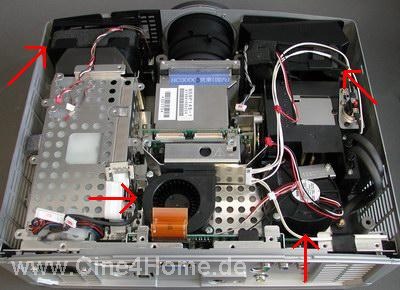
Several exhausts are placed throughout the projector (arrows).
The exhausts are of a quieter type which aren not completely bolted on but instead mounted using foam material.
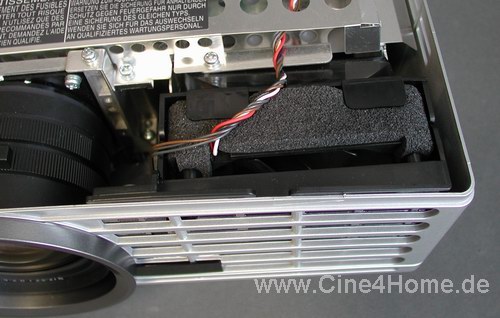
Above: an examplary noise absorbing exhaust
Below: the DMD chip's special fan

Not only noise level but also areas such as dust shielding have been improved. The additional dust filter of the HC900 (which was sold separately) is now included with the projector. The colour has been changed to fit the one of the new chassis.

Included: The additional dust filter.
The filter is removed using a handle on the air intake (right side) and makes sure no disturbing dust will enter the inner chassis.

The projector with the air filter inserted.
The heated air exits the projector on the other side of the lens.

The rear end: the cool air grid.

All in all, the new cooling system of the HC3000 is commendable. It's quiet, reliable and ensures that the lamp receives enough cooling to last a long time.

The HC3000 lamp module.
In eco mode, the lamp life is rated at an expected 3000 hours which makes the HC3000 a very economic purchase.
The DMD chip used in the HC3000 for image processing is completely new. This isn't the same as the usual 720p DC2/3 chips but instead a brand new DMD with a 12 degrees tilting angle and a resolution of 1280x768 pixels. The advantage of this new chip from Texas Instruments lies in its increased resolution and compatibility with standard PC XGA signals.
As always, we have taken a thorough and technical look at the light path:

In the image above, the structure is easy to make out: After leaving the colour wheel (1) the light passes through a small lens (2) in the DMD chamber. Via a bevelled mirror (3), it is directed at a sattelite dish-like mirror (4) and from there to the actual DMD chip (5) - something we have seen no other manufacturer do. From the DMD chip, the image is created, passed through the iris shutter (6) and finally the outer lens (7) from which it gets projected onto the screen.


Open Iris (left) and closed iris (right).
With the variable shutter, the light output, and thereby the black level, can be adjusted according to personal taste, image size and room conditions. For some reason, it is no longer possible to make adjustments in multiple stages. The only options available now are "on" and "off".
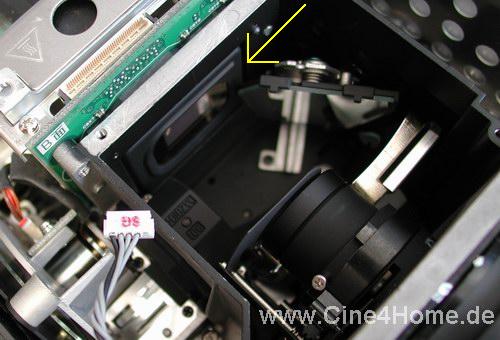
The light chamber from another angle
with visible DMD chip (arrow)
An advantage to this approach is the resulting high contrast. The manufacturer rates the HC3000's contrast at 4000:1. To accomplish this, the outer optics are a key factor. They have been made using purely glass components which should notably increase the in-image contrast and thereby the image depth.
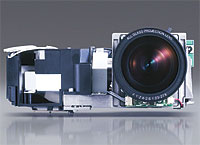
How close the official specs and the actual contrast level is will be tested in the upcoming image chapter of the review.
As we mentioned previously, all of these technical innovations are associated with a new data processor using "Brilliant Colour" technology which is supposed to improve colour reproduction a great deal.
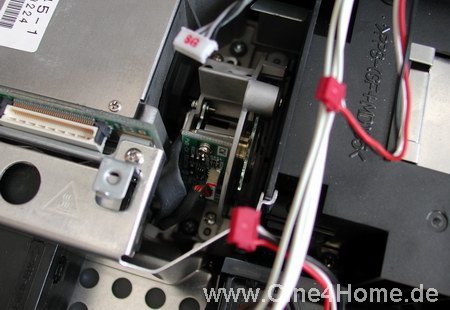
The colour wheel is positioned directly in front of the lamp (arrow)
Although no "RGBCMY" colour wheel was used (although supported by the hardware), the alignment of the primary colours has been much improved compared to the HC900. Especially the red segment has been further optimised.
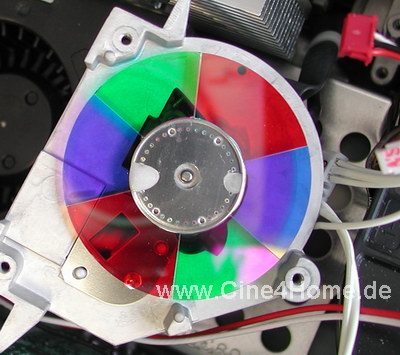
The HC3000 colour wheel with improved red segment
As you can see in the drawing above, the HC3000 comes with a six-segment (RGBRGB) colour wheel with an enlargened red segment. This compensates for the projector lamp's lack of red and makes an increase in contrast possible with correct colour reproduction. This will also be discussed in detail in our image test.
All in all, the technical construction as well as the innovations of the new HC3000 are remarkable. The projector is quiet, sensibly designed and has numerous new features which until now could not be found in this price range.
1.2 Connections / Signal types (Know How Link here)
The connections of the new Mitsubishi projector are almost unchanged compared to previous models. The DVI terminal has been exchanged for a HDMI terminal which seems slightly less robust than the DVI one but does support more image variants.

Completely new is the USB port, though we cannot say what its intended use is (apart from manufacturer service software).
The available connections are not remarkable but every signal type (480i/p, 576i/p, VGA, SVGA, XGA etc., 720p,1080i in both 50Hz and 60Hz) is supported through their own connection (analog/digital) which is fitting for the price range.
1.3 Setup (Know How Link here)
Unfortunately, the HC3000 does not have any mechanical lens shift like its predecessor. This means that the projector must either be adjusted with a variable eiling mount or as a last resort by tilting the projector.
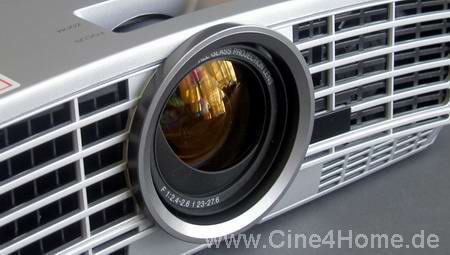
The zoom range is also not particulary high but adequate for most room conditions.
Projector throw range chart "HC3000"

Image Diagonal - Width - Height - Throw Range Max - Min
In any case, those interested in the projection capabilities of the HC3000 should be cautious when making plans for positioning the projector. The projector exhibits a certain "off-set" – meaning, the image's top/bottom edges are projected a bit higher/lower than usual.

Vertical Offset of the HC3000
When the projector is firmly placed, the sharpness and zoom can be manually adjusted on the lens. The mechanics seem to be of unusual good quality and just as resilient as you would need for a precise calibration.
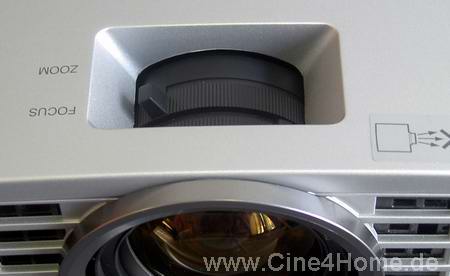
The HC3000's lens rings.
In conclusion, the compact size makes the projector suitable for most living rooms. As usual, the ease of setup that current LCDs offer is still not reached. Problems can occur with mounting in low ceilinged basements due to the rather high off set of the projected image.
2. Operating the projector (Know How Link here)
When operating the projector, the engineers' principle of keeping the predecessor's good features and improving where needed holds true.
2.1 Remote Control
The relatively large remote control has been replaced with a smaller and more economic version. We are dealing with an old acquaintance which numerous other manufacturers also use.
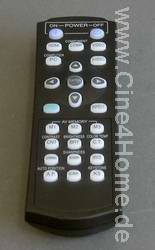
HC3000 remote control
Fortunately, this cost saving measure has in no way inhibited the possiblities of the user. The remote lies well in your hand, is back lit and has buttons for direct access to any relevant function or connection. On top of that, the range of operation is quite clearly longer than that of the predecessor, making it easy to control the HC3000 from any location.
Even without remote all basic functions are accessible through the buttons on the top side of the projector.

Button layout on projector's top side.
2.2 Menus
The basic menu structure of the HC3000 has not changed compared to the HC900, but additional functions have been added, which is an improvement.
All settings are divided into four main categories which are recognizable through the use of graphic icons. The first section deals with the functions necessary for calibrating the image.
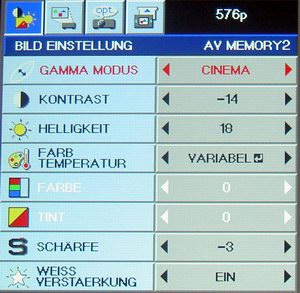
Image Menu
Here you can calibrate contrast and brightness as well as gamma and white level. Apart from various presets, it is now also possible to adjust the gamma curve separately on three levels (low, medium, high). This distinguishes the projector from the HC900 which did not offer this feature.
The white balance has also been improved. Individual gain and bias settings are now available for all three primary colors.

RGB settings of the HC3000
In the second category, additional settings dealing with the presentation and setup can be found.

Of particular interest here is the lamp mode, the aspect ratio/signal type as well as an integrated grid test image which makes adjusting the sharpness and zoom on the lens easier.
Among other things, the third category contains additional options for tinkering with the image signal (black level for instance).
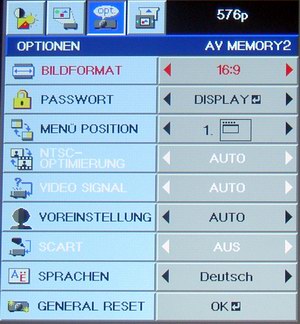
Last but not least we have the fourth category where different improvements over the HC900 are present. Here it is now possible to adjust overscan and even turn it completely off. It is therefore possible to adapt the image to any signal source.
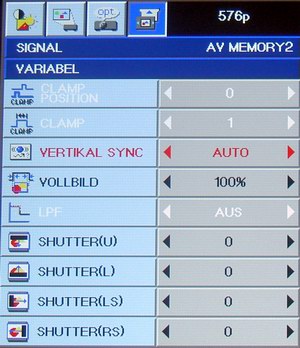
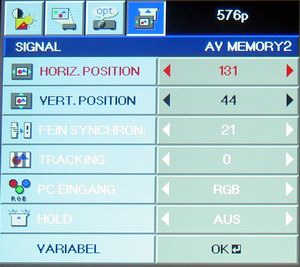
The image position is also adjustable.
A very useful feature is the blanking function where it is possible to outline all four edges of the image with black. This way, noise created by data running alongside the actual image (such as teletext or closed captions) can be eliminated.
All in all, the operation side of the HC3000 is very impressive with numerous functions which leaves little else to be desired. On top of that, they are both logical as well as intuitive in the way they are structured. The handy remote is quite suitable for navigating with ease.
3. Image quality
Already during our preview test, the HC3000 made a very good impression when it came to image quality. Lucklily, most of the positive experiences stay with the retail model which means most of this is a repetition of what we said in the preview test. Naturally we have carried the test out even more thoroughly and elaborated where needed.
3.1 Screendoor / Pixel structure (Know How Link here)
With the HC3000, we are dealing with the new 1280x768 chip from Texas Instruments for the first time. This marks a slight increase in resolution compared to the usual 720p chips. The gain in resolution results in a slightly less pronounced grid effect, but this will in most cases only be seen when feeding the projector its native resolution from a PC.
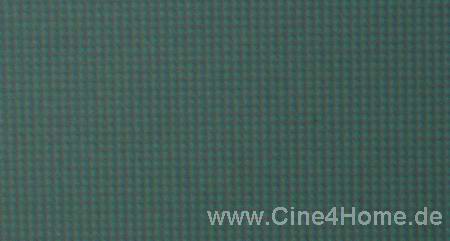
HC3000 pixel structure up close.
During movie playback, only 1280x720 pixels are used. This is also quite reasonable since only at this resolution one will get an image that corresponds to the 16:9 aspect ratio that widescreen movies use. This means that in spite of the higher native resolution of the chip, the pixel structure is still identical to normal HD DLP projectors. The high fillrate makes sure that the screendoor effect remains unobtrusive by normal viewing distances.
3.2 Color Space (Know How Link here)
The little predecessor HC900 had some small flaws in its colour range which did not correspond to the video standard. The new six segment colour wheel with improved filters makes sure that the HC3000 performs much better.
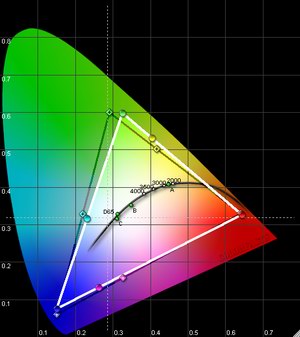
The diagram above shows the colour range of the projector (white triangle) compared to our PAL norm (dark triangle): Very good alignment of the primary colours where only green does not quite match its intended value. Most likely, the factory settings are slightly optimised for the NTSC standard. Nonetheless, the colour range is still exemplary for a DLP projector and quite often more pricey models will not be able to reach such accurate colour levels.
The secondary colours in the diagram above do not exactly hit the mark though. Especially yellow is a bit greenish which in some cases will hamper the naturalness of the image. These deviations can be traced back to the factory white balance (see the following chapter). Once the projector is calibrated at 6500k (D65), the secondary colours become perfect though:
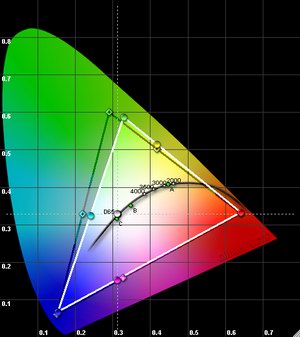
Exemplary colour range and well-aligned
secondary colours after calibration
With the above-mentioned optimisations of the colour range, all colours appear as natural on the screen as the people who mastered the DVDs had intended. The projector is therefore able to show very good results. Strong yellows, blue skies or nature scenes – everything is well-balanced and looks natural.
3.3 Color temperature (Know How Link here)
As we mentioned in the previous chapter, the factory defaults of the HC3000 do not correspond to the video standard completely. The HC3000 offers two preprogrammed tunings for white which are labelled "5900K" and "6500K". The video standard requires a white alignment of neutral gray tones at 6500K, also called D65. At recommended settings, the prototype model clearly deviated from this norm – a flaw that is also present in the retail model.

6500K Preset: unfortunately not really 6500K...
(Click image for enlargement)
As you can see in the diagram, there is clearly too little red in the image and a surplus of blue. This makes the resulting image in movies too cold, faces become too pale and especially artistically exaggerated scenes loose their effect. The resulting colour temperature at 8500k is 2000k above the norm:
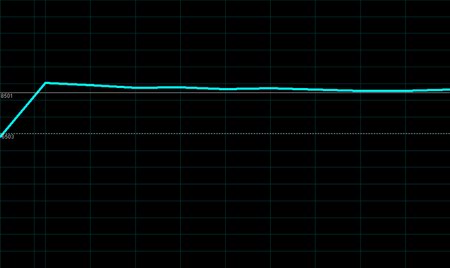
Image: 8500K instead of 6500K
(Click image for enlargement)
The surplus of blue is reduced slightly at the 5900k preset but there is still a clear lack of red, around 20%. The image reproduction is still too cold here.
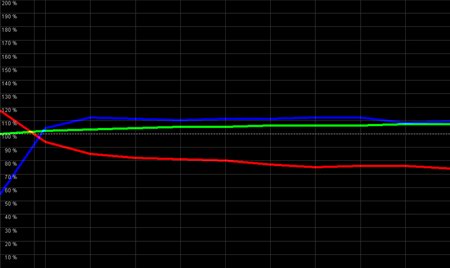
Colour balance in 5900k mode
(Click image for enlargement)
Luckily, the user settings have been much improved compared to the HC900. The special RGB menu now includes separate settings for contrast and brightness of the colour green:

RGB Menu – now "complete"
It is remarkable how precise the adjustments can be: after only a few minutes, very good results were accomplished:

Very good setting after a few minutes
(Click image for enlargement)
The combination of wide colour range and adequate 6500k setting (after manual realignment) results in an image which is both colourful and natural looking. The HC3000 can reproduce colours so accurately and finely nuanced that it trumps all other DLP projectors in its price range. In doing this, the new control chip with Brilliant Colour technology and 10bit video processing is quite helpful. Colour reproduction is therefore one of the advantages of the HC3000.
3.4 Black level, Contrast, Brightness (Know How Link here)
The real strength of DLP projectors is the high level of image depth which is reached through a combination of good black levels, high maximum brightness and good intra-image contrast. Still, in the last few months, DLP projectors in the lower price ranges have been especially lacking in this area without being able to surpass the competing LCD projectors. We were therefore quite exited to see how the new HC3000 in the below 3,000€ price range would perform.
In the manufacturer's specifications, an on/off contrast of 4000:1 is proudly stated. As often is the case, these ratings are rather generous. Our test model reached a maximum contrast of 3400:1, which still is a quite remarkable level. During movie use (while having accurate colour reproduction), this level is not possible to reach though. After a very thorough calibration, we came no higher than 2300:1. For a DLP projector, this is still very impressive. Combined with the high in-image contrast so typical of DLP projectors, the image appears both natural and three-dimensional in scenes both bright and dark. The more optimised the hometheater is (dark walls etc.), the clearer this advantage of the HC3000 becomes. In good hometheaters, the 2300:1 on/off contrast of the Mitsubishi HC3000 still produces a more three-dimensional image than that of current LCD projectors with contrast ratings of 4000:1 or more. The DLP technique is clearly still "the king" when it comes to contrast. The black level is therefore excellent and the maximum brightness is easily high enough for image widths of up to three metres (9 feet). Bright scenes will not look any less natural and if need be, the internal iris shutter can be opened a bit extra.
3.5 Luminance tracking / uniformity (Know How Link hier)
The relationship between Colour space and 6500k alignment can be compared to the one between contrast range and gamma distribution: the contrast range determines the dynamics range and the gamma distribution makes sure the most is made of the dynamics range. The relationship between incoming signal and outgoing brightness is roughly a factor of 2.2 when using current DVD mastering. As the HC900, the HC3000 has a very good factory alignment of the distribution of brightness.

Rise of 2.26
(Click image for enlargement)
The diagram above shows the factory setting of the "Cinema" preset: With a rise of 2.26, it comes very close to the current standard. The rise therefore corresponds to how an image with correct image composition and natural brightness distribution would look like. The average in dark scenes is on a fine level – even dark details are discernible. In bright scenes, no details are lost due to excessive brightness but instead retain their intended three-dimensionality. This factory preset is suitable for any kind of room. In dark hometheaters, steeper curves of up to 2.5 could be useful and would result an an image with even more depth to it. A new feature which was not in the HC900 is a special gamma equalizer which has been integrated into the image menu. Here the user can personally take control of the brightness distribution.
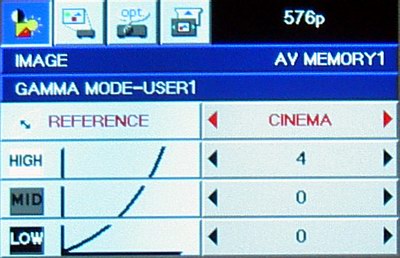
The HC3000 Gamma equalizer
For personal gamma settings, there are two separate save slots available to the user. Next, the reference curve can be selected – for normal hometheater applications "Cinema" is suitable. With the help of the equalizer, the user can now tune the gamma curve in three separate stages: "Low" influences dark areas, "Mid" the mid section of the gamma curve, and "High" the most bright portions. The equalizer was very accurate during our test and also quite simple to use. Using measuring instruments, steeper and even uniform gamma curves could be be aligned in only a few minutes:
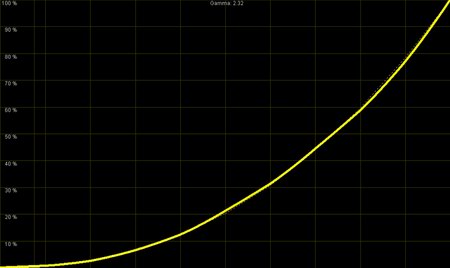
Self-calibrated gamma curve of 2.32
(click image for enlargement)
With the help of a wide range of settings, the experienced user can optimise the HC3000 to his personal preferences and surroundings. It is clear that Mitsubishi has realized that diverse settings have the potential of improving the image a great deal. Using either factory presets or by optimising manually, the HC3000 impresses with a good contrast rating and uniform gamma distribution resulting in a very three-dimensional and life-like image. The image presentation looks like what the filmmakers had intended. In this regard, the HC3000 is quite impressive.
Next to the Cinema mode and the gamma equalizer, the image menu of the HC3000 contains two additional presets, "Video" and "Sports". The latter is intended for sports viewing in rooms that are not completely dark:
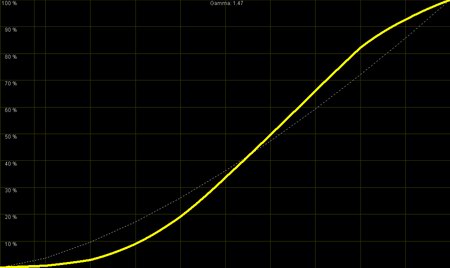
The rise of this brightness curve is quite steep in order to enlighten large image portions as much as possible and thereby making them recognisable when having light sources in the room. This does tend to make the image overly bright (clipping) which, when it comes to live broadcasts, is considered part of the deal. For movie use it is not recommended though...
All in all, the accuracy and flexibility of the HC3000 when it comes to brightness distribution is exemplary: Good factory setup with easy to use parameters to customize gamma to own preferences.
3.6 Sharpness / Brightness uniformity / convergence (Know How Link here)
In this section, we come to aspects of the image where the HC900 exhibited weaknesses. Since the HC3000 uses the same chassis, it is interesting too see if it has been improved...
The lens' sharpness is very good. The optics produce a uniformly sharp image even at the edges. When connecting it to a PC there is no loss of sharpness to see on the desktop.
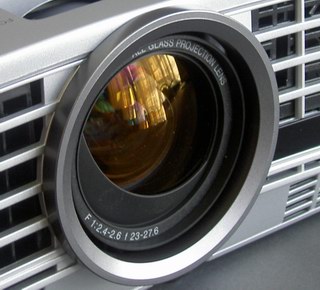
The optics mean everything when
it comes to sharpness.
When looking at the convergence, small flaws are apparent just as they were with the HC900. When using large zoom ranges, slight colour bleeding is visible around edges. Our test model showed small amounts of red/green misconvergence at maximum zoom.
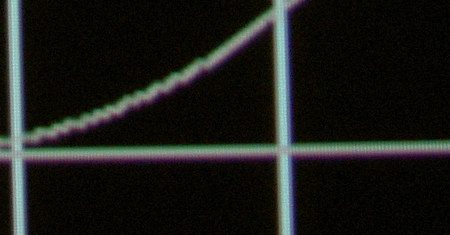
Slight misconvergence from the optics
The Chromatric Abberation is so low though that it does not disturb during movie use. Also, when not using maximum zoom, the convergence is close to perfect.
Something which has been improved is the illumination of the image: in our grey tones, we could only discern minimum light spill at the outer corners, but during movie use this is practically invisible. In this regard the HC3000 shows improvement compared to its little predecessor.
All in all, the optical characteristics have not changed much compared to the HC900. It is not perfect but in tune with the standard of the price range. All of the flaws are neglible enough to not hamper the impression of the image. The projector produces a uniformly illuminated and sharp image.
3.7 Overscan (Know How Link here)
We were especially delighted when we learned that our long time wish had been granted by the engineers. Normally, we are always highly critical of any projector with overscan that ca not be regulated or turned off. This is especially annoying if the overscan is much too high.
With the HC3000, a very nice overscan correction has been implemented. It can be set in small stages from 0 pixels (no overscan) to 40 pixels (high overscan).

Overscan can be set from "off" (above)
to "high" (below)
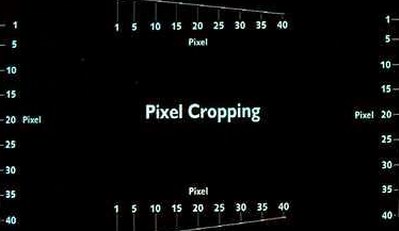
But it does not stop there. With the help of the "shutter function", additional overscan can be employed on every image edge (blanking). This funtion is especially practical when annoying off-image portions are visible above or below the image (Videotext for instance). Even without overscan it is possible to eliminate such effects easily.

Shutter for each image edge
Such a diverse menu for adapting the image source has not been seen by us since the Nec HT1100, and it is been quite some time since we laid or hands on the Nec. Our compliments to the engineers!
3.8 Noise / False Contour / Dithering(Know How Link hier)
While looking for typical DLP artifacts such as pixelation and colour reductions in subtle colour transitions, we made some very interesting discoveries. LCD and LCOS are rapidly gaining on DLP when it comes to contrast and correspondingly, Texas Instruments needs to further develop its DLP technology in order to keep up with the future analogue LC projectors. Room for improvement: the digital brightness reproduction via the tilted mirror intervals is one of the limiting factors at the moment. This causes image artifacts such as colour reductions (banding) and bad edges. In this regard, digital is (still) behind analogue.
To that effect, TI has further developed the much awaited DDP3020 data processor which has not been put to use in any projector prior to the HC3000.

Apart from an RGBCMY colour wheel (not included in HC3000) it also supports the so-called "Brilliant Color" technology which is supposed to improve colour reproduction and maximum brightness significantly through a more intelligent DMD control. Combined with faster memory modules (RLDRAM instead of DDR), the LVDS DMD interface should achieve more accurate colour nuances through a faster signal processsing (10bit) and thereby reduce DLP artifacts.
We have tested all of these promises at great length – we were especially critical on the subject of DLP artifacts since some of the more popular DLP projectors (Sharp Z2000, Toshiba MT700 or Benq 7700) clearly have deficiencies in this regard. Nonetheles, the new electronics did not let us down: the HC3000 surprised us with very good colour fidelity that did not produce any disturbing artifacts or colour reductions when watching movies. Colour transitions were also very fluid and banding was practically invisible. It is clear that the new electronics have had a very positive impact on the image quality. The annoying edge halos (double lines, ghosting during fast movements in dark areas) are still present but much reduced. Remaining is a slight touch of pixelation at up to 15% brightness which does not detract from the experience at normal viewing distances.
3.9 De-Interlacing (Know How Link hier)
The new signal processing should improve the de-interlacing – especially in film material. The HC900's de-interlacing was not exactly perfect in this area so how does the new HC3000 compare?
Video material
Video material consists of image content which was shot on ordinary video cameras - usually intended to broadcast purposes: sports, TV shows, interviews etc. Every half frame is a seperate snapshot. That means you get 50 frames per second with a vertical resolution of only 288 lines. The projector on the other hand only works in progressive (with higher resolution) so the missing lines are added by the de-interlacer.
Incoming video material such as most of our television programming is reproduced very well by the HC3000: Using motion adaption it seeks out unchanged portions of the image and puts the two half-frames together again using first the even and then the odd lines of the half-frames. This trick does not work with moving parts though since the half-frames will not match completely in these instances. The moving portions are interpolated in the actual resolution.
The presentation of video material is done very well by the HC3000. It is practically free from annoying line shimmering and is only slightly less sharp during movements. That means the projector is well equipped to handle any "TV event".
Film material
With film material (24 frames/second), every second half frame originates from the same movie image. To achieve the best projected image possible, these two half frames need to be rejoined again into a whole image. This approach is called "film mode". The HC900 had no proper PAL film mode in spite of having a resolution optimised for PAL. Sadly, this flaw has still not been rectified with the HC3000. In the image menu, the function "cinema mode" is available and reputedly it is capable of 2:2 pulldown, but at even small movements, the de-interlacer fails and looses the rhytm resulting in loss of detail. Doing film de-interlacing is therefore not one of the new projector's strengths – at least not when it comes to the PAL standard. This is quite a drawback but can be remedied with an inexpensive progressive scan DVD player (preferably with HDMI connection).
3.9 Details / Scaling / Sharpness (Know How Link hier)
3.10.1 Signal processing
Analog / Digital
Of great importance to detail reproduction is a projector's signal processing. The incoming signal, be it digital or analogue, must be transformed into some kind of data which can be recognised by the projector without introducing edge halos into the image. In its default settings, the HC3000 has a slight tendency towards edge haloing and at strong contrast transitions there is a bit of "ringing".

The shadows can be dealt with using the image menu's sharpness function, but beware of overdoing it or you will loose too much of the dynamics in small details.
3.10.2 Horizontal scaling
Analog / Digital
The 720 pixels of our PAL standard need to be converted by the HC3000's internal scaler into the native 1280 pixels of the projector. At best, the change in resolution should not lessen image quality (line fluctuations or interference).
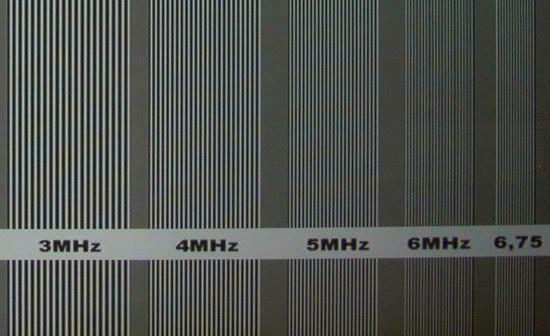
As you can see in the screenshot above, the scaling of the projector is exemplary precise and accurate. The difficult test image is accurately scaled to the projector's native resolution without any disturbing interference. Only in the 6MHz region are minor line fluctuations to be detected. With this level of scaling, the HC3000 is able to reproduce all of the original details in any movie image – even tiny details and small letters do not exhibit any kind of loss in sharpness.
Especially impressive is the colour fidelity of the projector: Both analog and digital do not suffer in the colours or brightness even at the highest frequencies.
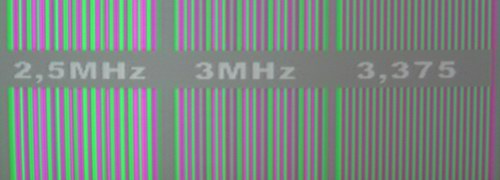
3.10.3 Vertical scaling
Vertically, the incoming signal's resolution needs to be converted too. From 576 lines (PAL) to 720 lines. "What do you mean 720, the projector has got 768 lines?" the attentive reader might ask. In reality, only 720 of the projector's 768 lines are used for video playback. This makes sense for two reasons: First of all, the chip will only be showing the 16:9 format accurately when it outputs 1280x720 pixels. Second, this means that 720p HD sources do not have to be scaled at all.
Notes:
-
When connecting a PC, it is possible to make use of the entire 1280x768 resolution of the projector. XGA will be displayed without any scaling.
- When displaying 4:3 material, the full 768 lines will be put to use. This is nice since vertical scaling is unavoidable anyway with 4:3 material.
Analog / Digital
The internal scaler showed good results in the vertical realm too. In the image below, you can see how the frequently used DVD resolution is presented without major interference artifacting.
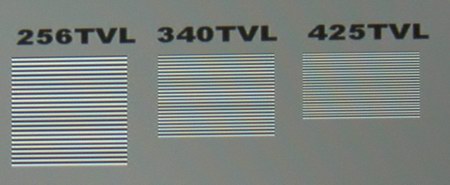
This will especially benefit vertical camera pannings with no unwanted moirée patterns to follow.
The very good scaling (horizontal as well as digital) and precise resolution reproduction results in a very sharp movie image which does not appear artificially exaggerated. Details look as detailed as those mastering the DVDs had intended. The image quality is therefore primarily influenced by the shortcomings of the medium itself and not the projector. Combined with the excellent optical sharpness, the HC3000 has no competition in its price range.
3.11 Rainbow- effect / eye strain (Know How Link hier)
"Last but not least" we have the well-known theme of "the rainbow effect". As always this DLP-only effect is still one of the main points of criticism. As we told in our preview test, Mitsubishi has equipped the HC3000 with a 4x colour wheel. It is capable of producing a colour frequency of between 200Hz (PAL) to 240Hz (NTSC).
As usual, we have measured the frequency and ended up at 200Hz using PAL material. This frequency corresponds to the current technical standard and should not be experienced as disturbing by most viewers. Still, there are models with even faster frequencies on the market. After talking with the manufacturer, a new aspect of the colour wheel's speed became clear: The HC3000's excellent colour fidelity with all nuances could only be achieved using a 4x colour wheel. The faster the wheel turned, the less time there was for the digital light modulation, resulting in less accurate colours. With the HC3000, colour accuracy has been given the priority to avoid annoying side effects like those of a HC2000.
Notes:
-
The rainbow effect is completely dependent on personal experience. That means: Test your own sensitivity to the rainbow effect personally by demoing the model before buying!
3.11
HDTV image impressions
When you buy a "HD ready" projector like the HC3000, making sure it is future proof is definately a factor. Even though HDTV did not break through this year, it is bound to happen next year – at the latest when the football world cup kicks off. This of course means that the HDTV performance of the HC3000 is essential. To test this, we have yet again used the best option available to consumers, a D-VHS/D-theater player. We connected it to the HC3000 and were quite impressed:
The projector processes the incoming 1080i signal without interlace artifacts and scales it accurately to a sharp 1280x720 image. The detail sharpness, which is free from edge halos, is at the highest level, even competing with substantially more costly DLP projectors. Having optimised the white level, the image on the screen is well-balanced in its colour fidelity, image depth, good black level and high maximum brightness. The finest nuances are nicely reproduced and artifacts caused by the image source or projection technique is of little consequence. There is no question that the projector benefits greatly from its modern signal processing.
All in all, the HC3000 delivers an image experience which in every respect is completely fresh and deserving of the "HD ready" label. Using high definition sources, the image quality is outstanding and comparable to that of significantly more expensive equipment.
4. Conclusion
Already in our preview test, it became evident that with the HC3000, Mitsubishi has made a remarkable projector for its price range. The HC900 was an excellent starting point, but many aspects such as resolution, signal processing and colour wheel have been much improved with the HC3000. The result is a second generation High Definition projector which in many ways is outstanding:
More than anything, the actual image quality is terrific. Great colour range due to optimised colour wheel components results in a very colourful image being projected onto the screen – one that corresponds nicely to the video standard while retaining a natural look. Unfortunately, the factory preset 6500K is not equally good, but after extensive calibrating you will find little to criticise in its colour reproduction. The 10bit signal processing with the new TI data processor allows a color accuracy with reduced DLP artifacts which until now could not be found in this price range. Whether the used colour wheel frequency of 200Hz is a problem is something you will need to determine with your own eyes.
The luminance tracking is also on a good level from the beginning but can also be calibrated to suit individual tastes with the built-in gamma equalizer. This ensures that you will get the most out of the 3400:1 contrast level (about 2300:1 with accurate colours). The latter is a very good level for a DLP projetor with high in-image contrast and ensures that the image is very three-dimensional. The image appears very realistic which as usual is one of the clearer advantages compared to good entry level LCD projectors.
The signal processing is very reliable when it comes to scaling and detail reproduction whether you are in digital or analogue waters. We were especially impressed by the natural look of the image which never seemed to be too digitally sharpened. The optical sharpness is also excellent, but depending on your amount of zoom, it can introduce some misconvergence into the image.
The very good image properties are mirrored in a comprehensive image menu with all relevant functions which are easy to use whether you are new to this field or an advanced user. More than anything, the variable overscan and blanking function are terrific innovations which are worth mentioning.
Image evaluation total : 1,9 (Good +) |
|
Black level & contrast |
1,4 (Good +) |
Luminance Tracking |
2 (Good -) |
Sharpness & interpolation |
2,1 (Good -) |
Colour range / -temperature |
1,5 / 2,2 |
De-interlacing |
2,5 (Good -) |
Other aspects |
1,9 (Good +) |
(All evaluations are based on the projection type and the current state of the technology in use. A direct comparison between the different types is therefore only partly usable)
The inner and outer design is very good for this price range: Compact construction, solid components and an appealing look all make the projector compatible with any living room. On top of that, the cooling has been so greatly optimised that it does not disturb the movie experience notably.
The ease of use through graphic symbols and text is very good and quickly becomes intuitive for the user. The reliable remote control has a longer range and is easy to use. The available functions cover any eventuality no matter the signal source or the room used for projection.
Still, despite the many positive characteristics, there are still some points which need to be criticised. The HC3000's setup possibilities first and foremost: Relatively small zoom range, the lack of horizontal and vertical lens shift as well as a quite large off-set (vertical shift on the optical axis) make positioning the projector far from problem free. It is definetely not possible to position the projector "anywhere" in the room which basically is what you can do with LCD entry level models. In most cases, you will need to position it slightly tilted which makes digital keystone correction a necessity. This is not to say that you should be scared off just because DLP projectors are less setup friendly. The minor compromises from using digital keystone correction is easily outweighed by the image quality: Most importantly, the high image depth through the excellent black level and large maximum brightness combined with high in-image contrast. It all more than makes up for any shortcomings.
All in all, you can clearly see the effort the engineers put into the HC3000. They have made affordable HD DLP projectors a reality with as few compromises to image quality as possible. That is a big plus since no other HD projector costing less than 3000€ has impressed us so much in a test as the HC3000 has. So anyone looking for a projector should read this as a heartfelt recommendation to go to the nearest hometheater store and see a demonstration. You will be surprised! High level DLP projection is finally affordable...
5. Results
+ Good construction, compact design
+ High resolution, HD ready
+ Ease of use
+ Vivid colours, large colour range
+ Many sensible settings
+ Few DLP artifacts
+ Good colour fidelity
+ Good contrast
+ XGA presentation without scaling
+ Additional dust filter making it safe from dust
+ Quiet during use
- No well-functioning PAL film mode de-interlacing
- Inaccurate colour factory settings
- Rainbow effect unavoidable for sensitive viewers
- Limited setup options (no lens shift, high off-set)
Evaluation total: 1,78 (Good +) |
|
Features |
1,9 (Good) |
Operation |
1,7 (Good +) |
Technology |
2 (Good) |
Image |
1,9 (Good +) |
Price / value |
1,4 (Good +) |
(All evaluations are based on the projection type and the current state of the technology in use. A direct comparison between the different types is therefore only partly usable)
3. Dezember, 2005, Ekkehart Schmitt
Translation: Jens Mogensen
6. Technical details (according to the manufacturer):
- System: DLP Dark Chip 2 with DDR3020
- Resolution: Video (1280*768)
- ANSI Lumens: 1000
- Contrast: 4000:1
- Lamp: 200w , 2000hrs.(typical)
- Lens: F2.4-2.6 Manual zoom and focus
- Interchangeable: No
- Image Size: 30" - 200" diagonal
- Throw Distance: 1.41m - 8.76m
- Keystone: Yes
Compatibility
- Computers: VGA , SVGA, XGA, SXGA
- Video: PAL,SECAM,NTSC,NTSC4.43,PAL-M/N
- Horizontal Freq.: 50-85kHz
- Vertical Freq.: 15-80Hz
- HDReady: Yes
Terminals
- VGA: 1
- HDMI: 1
- Component: 1
- S-Video: 1
- Composite: 1
- USB: 1
- RS-232: 1
General
- Remote
- Dimensions: 310mm(W) * 100mm(H) * 245mm(D)
- Weight: 2.9kg
- Power Supply: 100-240VAC, 50/60Hz
- Power Consumption: 280watts
